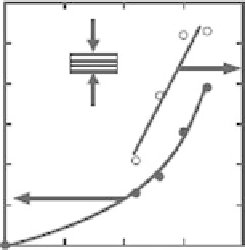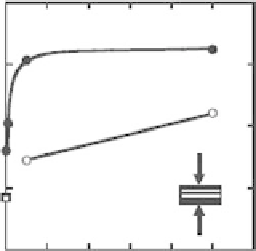Biomedical Engineering Reference
In-Depth Information
10
1
6.0
6.0
BC-Gelatin
5.0
5.0
10
0
4.0
4.0
Gelatin
3.1
10
−
1
3.0
3.0
3.6
2.0
2.0
10
−
2
5.8
BC
1.0
1.0
11
10
−
3
0.0
0.0
0.0
0.2
EDC concentration [M]
0.4
0.6
0.8
1.0
1.2
0
15 20
Amino Acid/Glucose [unit/unit]
5
10
(a)
(b)
Figure 9.14
Compressive modulus of a BC/gelatin composite as a function of crosslinker
density(a)andofnetworkunitratio(b)(39).(Nakayama,A.;Kakugo,A.;Gong,J.P.etal.,High
mechanicalstrengthdouble-networkhydrogelwithbacterialcellulose.Advanced Functional
Materials, 2004, 14(11), 1124-8. Copyright JohnWiley &Sons-VCHVerlagGmbH&Co.
KGaA.Reproducedwithpermission.)
fibroin film (355
56 MPa). However the composite films were more brittle than the
silk fibroin film with an elongation at break of only 2% and a tensile strength (9
.
4
±
±
1
.
2
MPa) slightly lower than that of the pure silk fibroin film (11
.
5
3
.
3MPa). Onthe
other hand, in the hydrated state, the composite was tougher and more flexible with an
elongation at break reaching 13
.
5
±
2
.
9% but exhibited very low tensile strength and
modulus. Besides the crystallization of the silk into the cellulose fiber mats appeared to
impart a high water resistance to the composite (40).
Solvent casted BC network/thermoplastic nanocomposites have also been developed
using cellulose acetate butyrate (CAB) as the matrix (26). BC/CAB nanocomposites were
prepared by impregnating an unpurified BC sheet into various CAB acetone solutions
and solvent casting such that a 10.3% (Composite A) and a 32% (composite B) volume
fraction BC nanocomposites were obtained. The tensile properties of the composites were
evaluated in static and cyclic modes and the fracture surfaces examined with SEM. The
stress-strain curves revealed an initial linear behavior followed by a yielding at a strain
of 0.6-0.8% and second linear region for strains higher than 2% (Figure 9.15). While the
strain at the maximum load was similar for the two composites at ca 3.5%, the Young
modulus and the tensile strength of BC/CAB nanocomposites improved significantly
with higher BC content. Tensile stiffness and strength more than doubled with ca 10%
addition of BC from 25.9 MPa and 1.2 GPa to 52.6 MPa and 3.2 GPa, respectively.
With 32% addition of BC, tensile stiffness and strength increased approximately 5 folds
to 128.9 MPa and 5.8 GPa. However the nanocomposites never reached the tensile
stiffness and strength of control BC films at 260 MPa and 15-18 GPa, respectively (9).
The cyclic test showed that in a loading cycle the unloading modulus was systematically
higher than the loading modulus and that the elastic moduli systematically increased
with each successive loading/unloading cycle, suggesting reorientation and slippage of
±


Search WWH ::

Custom Search